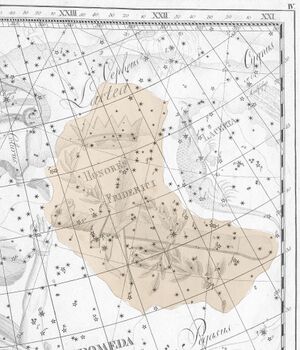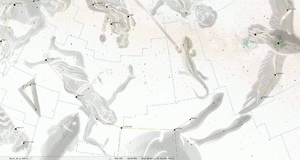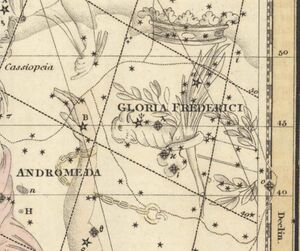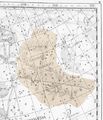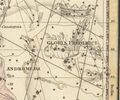Honores Friderici
This obsolete constellation was invented in France, but became more famous after a renaming in Prussia. In both cases, the constellation depicts some symbols of honour and admiration for the contemporary ruler. The Latin term "Honores" means honour. As a political constellation, it became obsolete with the global standardization of constellations by the IAU in the 1920s.
Etymology and History
Bode's creation
The young mathematician Johann E. Bode (1747-1826) named a constellation in honour of the Prussian king in German "Friedrichsehre", which can be translated as "honour of Frederick", the deceased king of Prussia. In Bode's greatest atlas, the Uranographia (1801), the constellation is depicted as a sword with laurel branches and a ribbon, and a crown on top. It's a named area without any recognizable star pattern.
The same depiction is inserted in the 1805 edition of his earlier (smaller) celestial atlas in German, first published in 1782 (without this new constellation). In this book, "Anleitung zur Kenntniß des gestirnten Himmels - Vorstellung der Gestirne", Bode's target group is the broad public and not an academic audience. He adds the new constellation in the Andromeda map (Tafel III) but not in the Pegasus map (Tafel XII). On Tafel XII, Andromeda's right arm is drawn as described in Ptolemy's Almagest with the hand marked by the stars κ, λ, ι And. In contrast, on Tafel III which shows the new constellation, Andromeda's arm had to be moved eastwards.
In the first edition of his 1782 celestial atlas, Bode does not yet have the new constellation "Friedrichsehre". He only adds it in a later edition: the third edition (1805) appeared after the showpiece "Uranographia" in 1801. There, it was added to the headline "Triangel" (Triangulum) which is the wrong place, as Triangulum is southeast of Andromeda and his new constellation northwest of her.
Bode's Reasoning
In the Astronomical Year Book for 1790 (published in 1787), Bode explains the meaning of the image: The sword acknowledges Frederick as a hero, the feather as a Wise Man, the olive branch as a peacemaker; the laurel stands, of course, for everlasting fame.
The position between the constellation of the celestial royal family was chosen by Bode, as he says because this position crosses right above Prussia (in zenith) during the honoured king's reign.
He dedicates three pages of the yearbook to this explanation and emphasises that the idea is supported by many European astronomers:
Am 25sten Januar d.J. hielt die hiesige Königl., Akademie der Wissenschaften eine öffentliche dem Gedächtnis und Lobe Friedrichs, Ihres Durchlauchtigsten Stifters, gewidmeten Versammlung. Diese Feyerlichkeit veranlasste mich, in einer kurzen Rede die Einführung eines neuen dem Andenken des unsterblichen Königs geweiheten Sternbildes unter der Benennung Friedrichsehre vorzuschlagen, und ich legte der Akademie die Figur desselben in einer stochenen Himmelscharte vor, woraus die Fig. auf Taf. II entlehnt worden.
Ich formire es zwischen der Cassiopeja, dem Cepheus, Andromeda und Schwan aus 76 zum Theil von mir neu beobachteten Sterne, und setze eine Stralenkrone, das Zeichen der Königl. Würde, an den Südl. Rande der Milchstr. nahe bey der Krone des Cepheus, weil im Jahrhundert Friedrichs die dort schimmernden Sterne, Seinem Erdenreiche senkrecht standen. Südwärts unter derselben hängen, mit dem unverwelklichen Lorbeer des Nachruhms umwunden: Ein Schwerdt, eine Feder und ein Oelzweig, um diesen ewig unvergesslichen Monarchen als Helden, Weisen und Friedensstifter zu bezeichnen.
Es ist bekannt, dass mehrere Astronomen der neuern Zeit berühmten Fürsten dergleichen Ehren-Denkmäler am Himmel gestiftet, und selbige gewöhnlich aus Sterne bildeten, die größtentheils zu benachbarten Gestirnen gehörten, auch dabey nicht selten genöthigt waren, dergleichen unwesentliche Abänderungen vorzunehmen, wie z.B. bey Formirung des neuen Bildes mir der einen Hand der Andromede und dem Hevelschen Eidexengestirn, welche erstere ich durch etwas mehr östlich stehende Sterne lege, und letzteres in eine schicklichere Lage bringe. Der Raum, den ich für meine Friedrichsehre gewählt hatte, schließt nach ddieser Änderung 49 schon in meinen Himmelscharten stehende Sterne ein. Hiezu suchte ich nun in einigen heitern Abenden des Januar-Monats noch 27 kleine dort herum stehende Sterne auf, und trug ihre Oerter nach einem genauen Augenmaaß in meiner gezeichneten Charte ein. Das neue Bild war nun aus 76 Sternen und zwey Sternhäuflein zusammengesetzt, worunter sich 4 Sterne von der 4ten, 3 von der 5ten, 24 von der 6ten, 16 von der 7ten, 24 von der 8ten, und 5 von der 9ten Größe befinden. Zum Pegasus gehören hievon 5; zur Andromede 26, zum Cepheus 6, zur Eidexe 9, und zur Cassiopeja 3 Sterne.
Die Russisch-Kayserl. Akademie zu Petersburg hat meinen wohlgemeinten und uninteressirten Vorschlag, Friedrich den Einzigen ein Denkmal am Sterngefilde zu stiften, gebilligt, und mir ihre Approbation schriftlich durch Herrn Prof. Euler unterm 24. April zugesandt. Es heißt am Schluss derselben: L'Academie applaudit à cet hommage que Mr. Bode rend à la mémoure d'un des plus grand Souvérains de son Siecle, et Messieurs les Astronomies consentierent avec plaisir d'employer le nom de la nouvelle Constellation, toutes les fois qu'il s'agira dans leurs observations des etoiles qui la composent. *)
Herr Layard, Secretair der Londner Köngl. Societät der Wissenschaften; schrieb unterm 7. Jan. im Namen der Societät an mich: The Royal Society receiv'd your present of Friedrichs Sternen-Denkmal, und J am directed to return you their thanks ce for the same. ---
Herr Justizrath Bugge schrieb dieserwegen aus Kopenhagen an mich unterm 26. Jun.: La Societé Royale a fort approuve votre hommage, et elle ne doute pas, que les astronomes de Dannemark seront Usage de votre nouvelle constellation, de son nom, et de sa figure dans leurs observations et dans leurs ecrits Elle m'a ordonne de Vous marquer sa approbation entiere.
Herr Mechain schreibt aus Paris unterm 23. Febr.: Je presenterai à l'Academie un de vos exemplaires de la nouvelle Constellation que vous aves formé à la gloire du grand frederic: Cette idée vous fait honneur et tous les philosophes ne peuvent qu'y applaudir, le nom de ce grand prince vivra éternellement et il mérite bien d'étre gravé ser la voute des cieux. --
Herr de la Lande scrhieb unterm 7ten May: J'ai reçu avec votre Lettre du 12. Fevrier la figure de votre nouvelle constellation, je l'ai communiquer à nos astronomes: j'en parlerai dans la nouvelle edition de mon Astronomie; personne ne s'interesse plus à la gloire de ce grand prince que moi qui fus pour ainsi dire Son ouvrage, puisque ce fut à Berlin en 1751 que je fis le premier voyage et les premieres observations qui m'ont ouvert la carriere de l'astronomie. --
Unterm 24. Jul. schrieb Herr Prof. Euler an mich: dDas hiesige Directorium der Volksschulen hat bereits das neue Sternbild Friedrichsehre auf einer bey demselben von dem Herrn Hofr. Gollovin besorgten Himmelskugel auftragen lassen.
Noch haben verschiedene Astronom. mir ihren Beyfall über das vorgeschlagene Sternbild in Briefen zu erkennen gegeben.
Bode.
English.
On January 25 of this year, the local Royal Academy of Sciences held a public meeting dedicated to the memory and praise of Frederick, its most illustrious founder. This solemnity prompted me to propose in a short speech the introduction of a new constellation dedicated to the memory of the immortal king under the name of Frederick's Honor, and I presented the Academy with the figure of the same in an engraved celestial embrasure, from which the fig. on Pl. II has been borrowed from.
I formed it between Cassiopeia, Cepheus, Andromeda and Swan from 76 stars, some of them newly observed by me, and placed a ray crown, the sign of royal dignity, on the southern edge of the Milky Way near the crown of Cepheus, because in Frederick's century, the stars shimmering there were perpendicular to his earthly realm. Hanging southward beneath it, entwined with the unfading laurel of posthumous fame: A sword, a feather, and an olive branch to mark this eternally unforgettable monarch as a hero, sage and peacemaker.
It is known that several astronomers of modern times have donated such honorary monuments in the sky to famous princes and usually formed them from stars that, for the most part, belonged to neighbouring celestial bodies and were not infrequently forced to make such insignificant changes, as for example in the formation of the new image with one hand of the Andromede and the Hevelian lizard constellation, which, the first one, I place at stars standing somewhat more to the east and bring the latter into a more suitable position. After this change, the space I had chosen for my Frederick's Honor includes 49 stars that are already in my celestial orbits. In addition, on a few bright evenings in the month of January, I sought out another 27 small stars standing around there and entered their positions in my drawn chart according to an exact eye measurement. The new image was now composed of 76 stars and two star clusters, including 4 stars of the 4th, 3 of the 5th, 24 of the 6th, 16 of the 7th, 24 of the 8th, and 5 of the 9th magnitude. Of these, 5 belong to Pegasus, 26 to Andromede, 6 to Cepheus, 9 to Lizard and 3 to Cassiopeia.
The Imperial Russian Academy in Petersburg approved my well-intentioned and uninteresting proposal to erect a monument to Frederick the Unique at the firmament and sent me its approval in writing through Prof. Euler on April 24. At the end, it says [in French]: The Academy applauds this tribute paid by Mr. Bode to the memory of one of the greatest scientists of his century, and the Astronomical Society is pleased to agree to use the name of the new Constellation whenever the stars of which it is composed are observed.
Mr. Layard, Secretary of the Royal Society of Sciences of London, wrote to me on behalf of the Society on 7th Jan.: The Royal Society received your present of Friedrich's Star Monument, and I am directed to return you their thanks for the same. ---
Herr Justizrath Bugge wrote to me about this from Copenhagen on 26 Jun. [in French]: The Royal Society has greatly approved your homage, and it has no doubt that the astronomers of Dannemark will use your new constellation, its name and its figure in their observations and in their writings. It has ordered me to give you its full approval.
Mr. Mechain writes from Paris on 23. February [in French]: I will present to the Academy one of your exemplars of the new constellation which you have formed in the glory of Frederic The Great: this idea will do you honour and all the philosophers can only applaud it, the name of this great prince will live forever, and it deserves to be engraved in the hearts of the people. --
Mr. de la Lande wrote on May 7th [in French]: with your letter of February 12, I received the figure of your new constellation, I communicated it to our astronomers: I will speak about it in the new edition of my astronomy; nobody is more interested in the glory of this great prince than I who was, so to speak, His work, since it was in Berlin in 1751 that I made the first voyage and the first observations which opened to me the career of astronomy. --
On 24. On July 24, Prof. Euler wrote to me: The local directorate of elementary schools has already shown the new constellation Friedrichsehre on a sky chart provided by Court Councillor Gollovin on a celestial sphere provided by him.
Various astronomers have also written to me to express their approval of the proposed constellation.
Bode.
Bode's explanation makes it clear that he had not secretly created a new drawing in one of his atlases, but rather had ensured its approval by the European community of astronomers. Although it is a political constellation to honour the Prussian king, his personality as a promoter of science was acknowledged all over Europe.
Star Catalogue compiled by WGSN
| id | description | ident. | Vmag |
|---|---|---|---|
| 1 | westernmore in the head of the sword | λ And | 3.82 |
| 2 | south of the head of the sword, at the ribbon | κ And | 4.14 |
| 3 | next to the one south of the head of the sword | ι And | 4.29 |
| 4 | in the head of the sword | ψ And | 4.966 |
| 5 | at the end of the sword | ο And | 3.62 |
| 6 | above the one at the end of the sword | 2 And | 5.25 |
| 7 | the southern one of the two in the laurel branch at the end of the sword | HIP 113802 | 6.42 |
| 8 | the northern one of them | HIP 113750 | 6.43 |
| 9 | at the tip of the leaf of the laurel branch at the end of the sword | 4 And | 5.294 |
| 10 | at the ribbon next to the laurel branch at the end of the sword | HIP 114981 | 6.4 |
| 11 | the one in the middle bottom part of the sword | 6 And | 5.9 |
| 12 | the one where the feather leaf intersects the sword | 13 And | 5.736 |
| 13 | at the end of the ribbon in the middle of the sword | 15 And | 5.563 |
| 14 | at the end of the feather | 14 And | 5.2 |
| 15 | the lonely one under the entire ornament | 12 And | 5.765 |
| 16 | westernmost in the feather | 3 And = HIP 113919 | 4.6 |
| 17 | in the feather | 5 And | 5.65 |
| 18 | in the feather | 7 And | 4.5 |
| 19 | in the feather | 8 And | 4.8 |
| 20 | in the feather | 11 And | 5.4 |
| 21 | lower in the northernmost laurel branch | HIP 115996 | 6.15 |
| 22 | upper one in the northernmost laurel branch | 18 And | 5.35 |
Marked only in the Uranographia (not enough stars in the 1805 edition)
| id | description | ident. | Vmag |
|---|---|---|---|
| HIP 116940 | |||
| HIP 116941 | |||
| HIP116582 A | |||
| HIP 117340 A | |||
| crown | HIP 112731 | ||
| crown | HIP 113561 | ||
| crown | HIP 114622 | ||
| crown | HIP 114924 | ||
| crown | HIP 114162 | ||
| crown | HIP 113501 | ||
| ... | |||
Bode's predecessor Royer
Although Bode does not mention any sources, it is frequently pointed out that Bode's constellation likely was inspired by the earlier French invention of the constellation "Sceptrum" by Augustin Royer who lived in the time of Louis XIV.[1] Royer had dedicated two constellations in honour to his king, the "Sun King" of the absolutist monarchy: the French national emblem, the Lily (Lilium, today surviving in the star name Lilii Borea), and the Sceptrum et Manus Iustitiae (Latin for "The Scepter and the Hand of Justice"). As Royer had obtained his star coordinates from the Carthusian monk Anthelme Voituret (1618-1683), whose work is not independently preserved but only in Royer's correction for the equinox 1700, it remains unknown who of the two invented this constellation.[2]
Royer's constellation was larger than Bode's as it also covered the area of Lacerta. Royer seems to have covered the empty area first, but in Bode's time Hevelius's influencial atlas had defined the Lizard there, and Bode had to shift Andromeda's arm to make room for the sceptrum.
| id | description | ident. | Vmag |
|---|---|---|---|
| 1 | the one in the middle of the hand | α Lac | 3.77 |
| 2 | the one at the pointer finger of the hand | β Lac | 4.4 |
| 3 | the one where the thumb joins | 4 Lac | 4.55 |
| 4 | the one where the little finger joins | 9 Lac | 4.6 |
| 5 | the eastern one of the three in the scepter | 8 And | 4.8 |
| 6 | the middle one of them | 7 And | 4.5 |
| 7 | the western one of them | 3 And | 4.6 |
| 8 | the one at the root of the hand | 5 Lac | 4.3 |
| 9 | the eastern one at the intersection of scepter and hand | 11 Lac | 4.5 |
| 10 | the western one of them | 6 lac | 4.5 |
| 11 | the northern one of the two at the end of the scepter | HIP 109754 | 4.65 |
| 12 | the southern one of them | 1 Lac | 4.1 |
| 13 | the easternmost at the ribbon around the intersection | 15 Lac | 4.95 |
| 14 | the southern one of the two at bottom part of the stick of the hand | 10 Lac | 4.85 |
| 15 | the northern one of them | 8 Lac | 5.65 |
| 16 | the one at the ribbon, west of the hand | 2 Lac | 4.55 |
| 17 | the one at the western end of this ribbon | HIP 109102 | 5.05 |
Name Variants
Ian Ridpath[1] pointed out that the international derivatives of Bode's Uranographia (1801) occasionally offered the variant "Gloria" instead of "Honores". Jamieson’s atlas named it Gloria Frederici, as did Urania's Mirror, while Burritt had the slightly different Gloria Frederica (both Burritt and Urania’s Mirror copied from Jamieson, who in turn relied on Bode as primary source[3]).
R. H. Allen,[4] for some reason, turned the name round to become Frederici Honores. but we couldn't find any other source which gave that name.
Transformation and Variants
Mythology
IAU Working Group on Star Names
In 2023, it was suggested to keep the memory of this obsolete constellation by naming a star "Honores" or "Gloria" without any political reference - neither the French nor the German. The general concept of "honour" or "glory" of all humans who support science - might that be as taxpayers, political rulers or patrons - could be honoured with this star name. The brightest stars of the obsolete constellation are λ And (3.8 mag) κ And (4.15 mag) ι And (4.25 mag) and ο And (3.7 mag). λ And has an ancient Babylonian star name (Asidu ša U8.KA.DU8.A), and κ, ι And form the hand of Andromeda in the Almagest. Thus, ο And (3.7 mag) is recommended for the name "Honores".
WGSN decided ... in the IAU-CSN.
Weblinks
Reference
- References (general)
- References (early modern)
- Ian Ridpath's website (Star Tales )
- ↑ 1.0 1.1 Ian Ridpath, Star Tales (1988, Online Edition).
- ↑ Warner, D. (1979). The Sky Explored - Celestial Cartography 1500-1800. Theatrum Orbis Terrarum, Amsterdam.
- ↑ Kanas, Nick (2012, 2019). Star Maps. History, Artistry, and Cartography, Springer Science & Business Media, ISBN 1461409179, 9781461409175 (online version).
- ↑ Allen, Richard Hinckley (1899). Star Names - Their Lore and Meaning. Dover Publications, Inc., New York
